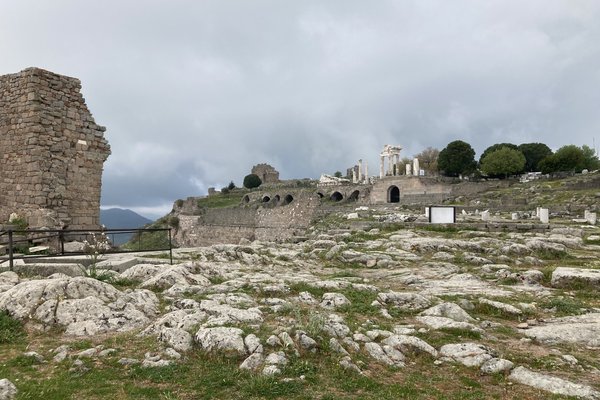Turkiye
Pergamon
Pergamon and its Multi-Layered Cultural Landscape show remains of the Hellenistic Attalid, Roman, Byzantine and Ottoman empires.
Pergamon was built into the slopes of Kale Hill and developed into a full acropolis during the Hellenistic and Roman periods. The Anatolian Kybele Sanctuary represents the continual use of the site. The city eventually became the capital of the Roman province of Asia, known for its Asclepieion healing centre.
Community Perspective: The site in and around the modern city of Bergama comprises 9 locations. Jarek has covered them all, and zooms in on the tumuli and the (inaccessible?) Kybele sanctuary. Others like Solivagant, Juha and Clyde have focused their review on the main component, the Acropolis. Nan has described getting there on public transport.
Site Info
Official Information
- Full Name
- Pergamon and its Multi-Layered Cultural Landscape (ID: 1457)
- Country
- Turkiye
- Status
-
Inscribed 2014
Site history
History of Pergamon
- 2014: Advisory Body overruled
- ICOMOS advised Deferral
- 2014: Inscribed
- Inscribed
- Type
- Cultural
- Criteria
- i
- ii
- iii
- iv
- vi
Links
- UNESCO
- whc.unesco.org
- Official
-
- muze.gov.tr — Bergama Acropolis
- muze.gov.tr — Bergama Asklepion
- Related
-
- en.wikipedia.org — Story of the Pergamon Altar
All Links
UNESCO.org
- whc.unesco.org — whc.unesco.org/
Official Website
- muze.gov.tr — Bergama Acropolis
- muze.gov.tr — Bergama Asklepion
Related Resources
- en.wikipedia.org — Story of the Pergamon Altar
Community Information
- Community Category
- Archaeological site: Ancient Greece
Travel Information
Izmir Hotspot
Recent Connections
-
Izmir Hotspot
Izmir - Bergama dolmus (1.5h travel tim… -
Cult of Cybele
The Kybele Sanctuary at Kapıkaya, with … -
Hellenistic Greece
The acropolis of Pergamon, with its urb…
Connections of Pergamon
- Individual People
-
-
Ibn Battuta
"We continued our journey from Maghnisiyah and came to the city of Barghamah [Bergama/Pergamon], a city in ruins, with a great and formidable fortress on top of a hill." -
Timur
The city fell to the Ottomans in 1345, then briefly to the Mongols under Timur before being taken again by the Ottomans under Murat II (1421-1451)(AB ev) -
Theodor Wiegand
"He discovered, in 1927, the arsenals of the castle at the acropolis and excavated the large sanctuary of Asklepios outside the city." (Wiki). Published "Bericht über die Ausgrabungen in Pergamon" 1927, Berlin
-
- Trivia
-
-
Modelled after
They remodeled the Acropolis of Pergamon after the Acropolis in Athens (wiki) -
In the Pergamon museum
Great AltarSee en.wikipedia.org
-
- History
-
-
Hellenistic Greece
The acropolis of Pergamon, with its urban planning and architectural remains is an outstanding ensemble of the Hellenistic Period. (OUV) -
Located in a Former Capital
It became the capital of the Kingdom of Pergamon during the Hellenistic period, under the Attalid dynasty, 281-133 BC. (wiki) -
Byzantine Empire and Civilization
rebuilding of the city walls during the Byzantine period, reusing stones from earthquake-damaged monuments (AB ev) -
Ottoman Empire
The city fell to the Ottomans in 1345, then briefly to the Mongols under Timur before being taken again by the Ottomans under Murat II (1421-1451)(AB ev) -
Ancient Greek colonies
Philetaerus from Macedonia founded the Attalid dynasty that established the Hellenistic city of Pergamon
-
- Architecture
-
-
Brick architecture
Red Basilica -
Rock Cut Architecture
The Kybele Sanctuary at Kapikaya is a rural rock-cut sanctuary (AB ev)
-
- World Heritage Process
-
-
Cultural landscape not recognized
Is titled a CL and it was clearly accepted as a CL by ICOMOS -not clear why it isnt on the UNESCO CL List
-
- Religion and Belief
-
-
Mentioned in the Bible
Red Basilica was one of the Seven Churches to which the Book of Revelation was addressed (Revelation 2:12). (wikitravel) -
Converted Mosques
There's now a mosque in one of the buildings of the Byzantine Red Basilica (wikitravel) -
Cult of Cybele
The Kybele Sanctuary at Kapıkaya, with local Anatolian roots, represents the continual use, synthesis of cultures and interchange of human values through time. (OUV crit II) -
Serapea
Red BasilicaSee en.wikipedia.org
-
- Human Activity
-
-
Locations for playing sport
gymnasium
-
- Constructions
-
-
Aqueduct
Water was brought to cisterns and fountains on Kale Hill (which had no source of its own) by ceramic pipes and lead pipelines under pressure from mountains some 50km to the north of the city (AB ev) -
Theatres and Opera Houses
remains of a theatre (AB ev) -
Baths
Roman baths complex -
Columbarium
includes remains of a Columbarium" within the main component, AB evaluation, pg 281 -
Acropolis
"The acropolis remained as Pergamon’s crown while the city developed on the lower slopes" (OUV)See en.wikipedia.org
-
Asklepieion
Sanctuary of Askelpius "Further to the south-west the Asclepieion healing centre was developed under the great physician and pharmacist Galen, with its own theatre, temple to Zeus-Asclepius, sacred fountain, circular treatment building, and connected to Kale Hill by a 1km sacred way. The centre reached its peak of importance in the 2nd century AD as a famous sanctuary for pilgrims seeking a cure." (AB) -
Suspended cable cars
Bergama Akropol Teleferik up to the Acropolis / 2010 / 700m, 4 minsSee en.wikipedia.org
-
Tumuli
Ikili tumuli
-
- Timeline
-
-
Built in the 3rd century BC
The first Hellenistic city of Pergamon was established by the former Macedonian army officer Philetairos from 282 to 263BC (AB ev)
-
- WHS Hotspots
-
-
Izmir Hotspot
Izmir - Bergama dolmus (1.5h travel time (one way), departs at every 20 min)
-
- Science and Technology
-
-
Libraries
"Pergamum was home to a library said to house approximately 200,000 volumes, according to the writings of Plutarch.[3] Built by Eumenes II between 220 and 159 BCE and situated at the northern end of the Acropolis, it became one of the most important libraries in the ancient world." (wiki)See en.wikipedia.org
-
News
No news.
Recent Visitors
Visitors of Pergamon
- Adolfo
- Adrian Turtschi
- Alexander Barabanov
- Alexander Lehmann
- alicemears
- Ali Zingstra
- A. Mehmet Haksever
- Andrew_Kerr
- Argo
- Artur Anuszewski
- Atila Ege
- bergecn
- Bill Koo
- Bill Maurmann
- Bin
- butterflybird
- Can SARICA
- CeeCeeSR
- Chalamphol Therakul
- Cheryl
- Christian Wagner
- Christine
- christof
- Christravelblog
- Chunsian01
- Clyde
- Corinne Vail
- CugelVance
- Dagmara
- Dani Cyr
- Dan Pettigrew
- David Berlanda
- Dimitar Krastev
- Elaine McArdle
- eljx1988
- Els Slots
- Eric Lurio
- Erik Jelinek
- Ertai
- Eva Kisgyorgy
- Evgenii
- Fan Yibo
- Farinelli
- Felicité
- Francky D'Hoop
- Garrett
- George Gdanski
- GerhardM
- Gjert
- Hadrianus
- Harald T.
- Harry Mitsidis
- Hasco
- H Beswick
- Hdhuntphotography
- Hdwilsonau
- henryjiao18
- Hubert
- Hughes1920
- Iain Jackson
- IreneKD
- Ivan Rucek
- Jan Korpeg
- Janos
- Jarek Pokrzywnicki
- Jawnbeary
- Jeffrey Chai
- Jezza
- JL
- John Smaranda
- Judit Andrea Juhász
- Juha Sjoeblom
- KarenBMoore
- Kbecq
- KeithBailey
- KentishTownRocks
- Kjlauer
- Knut
- Krijn
- Kurt Lauer
- La Concy
- Lado Joel
- Lembu
- lichia
- Ludvan
- Luis Filipe Gaspar
- Luke LOU
- Maciej Gil
- Malgorzata Kopczynska
- marc Rouserez
- Martin
- Martina Rúčková
- maryhattie
- MaYumin
- Mazeman
- Mia esguerra
- Michael Ayers
- Mikko Syrjä
- Milan Jirasek
- Miloš Tašković
- miri2808
- Monica Tasciotti
- nan
- Nick M
- Nihal Ege
- PabloNorte
- Patrik
- Paul Schofield
- Philipp Leu
- Philipp Peterer
- Pink Bunny
- Rachel Perkins
- Rafał Kałczuga
- Randi Thomsen
- Reza
- Rick Ohm
- Risson
- RobRos
- Roger Ourset
- Rolf
- Roman Bruehwiler
- Sandmann15
- Sclowitz
- Solivagant
- Ssong.x
- Stanislaw Warwas
- Svein Elias
- Szucs Tamas
- Tammy Gouldstone
- Tarquinio_Superbo
- Thomas Buechler
- Thomas Harold Watson
- Thomas van der Walt
- Thorben
- Tim Allen
- Timothy C Easton
- tony0001
- triath
- Twobaconsandaboston
- Vernon Prieto
- Viaje al Patrimonio
- Vsacan
- wantrain.
- Wojciech Fedoruk
- Xiong Wei
- Yevhen Ivanovych
- Zoë Sheng
Community Reviews
Show full reviews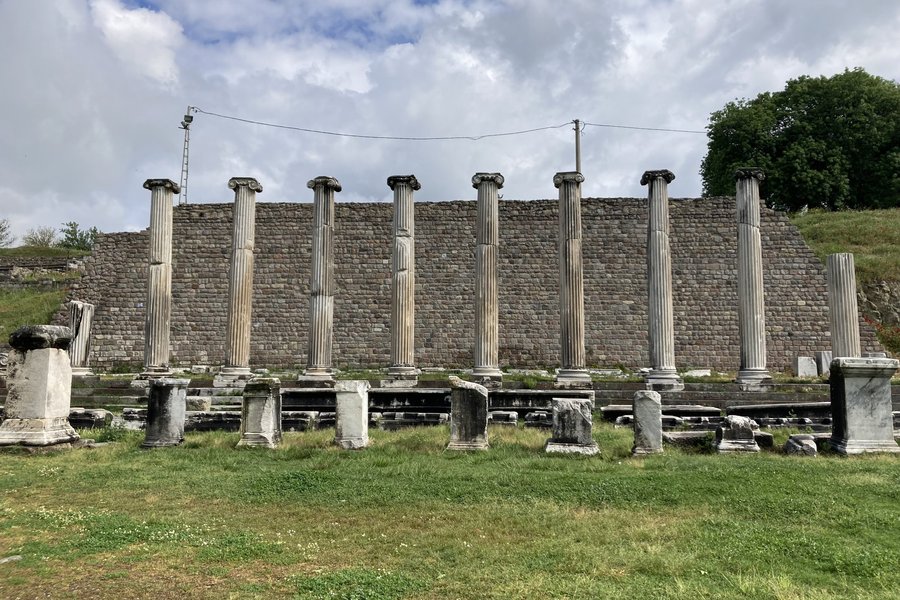
The most surreal experience I've ever had at a museum. The upper part was full of people and clean, but the lower half with the agoras and the Olympeion was totally empty, with cows grazing and pooping everywhere, and nighly illegible signs. The UNESCO sign was also missing because it was broken? How does that even happen lol?
Fun fact: Pergamon is the origin of parchment
Keep reading 0 comments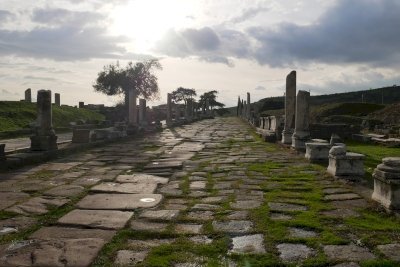
Pergamon is spread across multiple areas of the modern city of Bergama. The official locations given by the inscription are a bit misleading as the main components are grouped into the "city", while minor parts, e.g., the many tumuli each get their own.
In the city locations of note are:
- Situated atop of the hill overlooking the town is the ancient Acropolis. As fortresses from antiquity go, this is stellar. Admittedly, signposting and trails were lacklustre, especially, if you descend from the hilltop.
- On the foot of the hill is the Red Hall. The state of preservation or presentation is rather poor, but the dimensions of the temple from antiquity are stunning.
- Personally, the best component I visited was the Asklepion. It's a bit off the central city, but had wonderful views of the acropolis and radiates a wonderful tranquillity.
The modern city itself is a sprawl. There are Ottoman roads and houses, but always mixed with modern concrete buildings. I am not sure; I would consider this part of the OUV as I have seen better Ottoman towns.
As pointed out by previous reviewers, a major component of the original site is now housed in another WHS. The Pergamon Altar is shown on the Museumsinsel in Berlin in the aptly named Pergamon Museum. They have been renovating the whole Museumsinsel for decades, but I think the museum is open for visitors. In Bergama, you will find a stele …
Keep reading 0 comments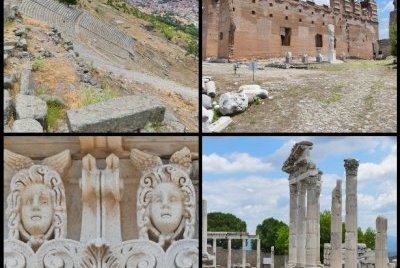
I visited this WHS in Spring 2021 focusing first on the many lacklustre tumuli and the Kybele Sanctuary in the 8 locations close to Bergama town, Islamsaray and Kapikaya leaving the multi-layered (Hellenistic, Roman, Byzantium and Ottoman periods) city last.
Before driving up the steep road all the way up to the Acropolis, the Asklepeion and Red Hall (you can also take the cable car up if you don't want to drive to the top), I took in the interesting Red Hall/Temple of the Egyption Gods. When I visited, there were no apparent restrictions due to the COVID pandemic so I gladly visited these sites too before heading uphill to the Acropolis. There are old rusty brown metal UNESCO signs at most locations and the usual Turkish UNESCO WHS sign next to the Acropolis entrance.
The name Pergamon or Bergama means fortified area. Philetairos existed as a powerful kingdom from 283 BC. It fell under the Roman domination pursuant to the will of Attalus III in 133 BC, and the city started to reshape under the influence of Christianity when the Roman Empire began to lose power and divided in two. In the 8th century BC, Pergamon was exposed to Arab invasions and in the early 14th century it joined the Menteshe Beylik. The city was included in the Ottoman territories by Orhan Gazi in 1345 and the Turkish period began. The ancient city of Pergamon stands out with its successful urban planning despite the topographic difficulties.
…
Keep reading 0 comments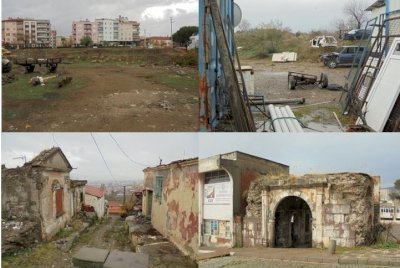
Site just visited (December, 2020), not an easy time to visit Turkey during covid-pandemic restrictions. As all other reviews are focused on main component and the most spectacular part of the heritage I will describe other places.
First of all - consider to spend some more time in Bergama (Pergamon). All the sites are scattered around the city. Also the main component - space around Acropolis / Asclepion and the lower (Ottoman) town (multi layered city) covers itself relatively big area. Even if all paid areas were closed due to coronavirus I spent almost full day exploring the area and wandering the streets of Ottoman town.
While describing I will use official names from our website.
Kybele Sanctuary at Kapikaya, located some 7 km north from central Bergama. On a basis of coordinates from our website the site is located on a rocky hill. It seems as there is no access from the main road (Kozak Bergama Yolu) – the rocks are too steep. Also no access from the side road to the left (fenced houses). I did not find any path leading to the site. There are no signposts nor guideposts in the area. As I had heavy rain I did not try to get closer. But at least all the area around the rocks is a buffer zone.
Ilyas Tepe Tumulus – located on the hill next to Acropolis. As in previous site there are no signposts / guideposts of the place in the …
Keep reading 0 comments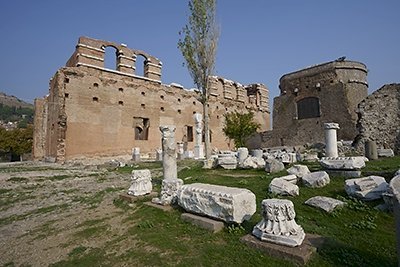
To be such a late inscription Pergamon is an impressive, diverse and large site. And hordes of tourists haven’t yet discovered it which makes it enjoyable site to visit. Compared to Pamukkale and Ephesus, which are surrounded by tourist villages, Pergamon is an authentic city that lives its own life. There were some tourist groups in the Acropolis but otherwise the sites were quite empty. I visited Pergamon on my exploring of four classical sites of Western Turkey on October 2019.
Getting from Izmir to the city of Bergama is quite easy. The only reasonable public transport option is bus. Mini buses depart every hour from the second floor of the main bus station. Note that only the mini buses go to the center of Bergama. The terminus of mini buses at Bergama is so called Soma Garage. Long distance buses stop only at the main bus station of Bergama which is located seven kilometers from the city center.
The World Heritage Site of Pergamon has ’Multi-Layered’ on its name. The different layers belong to the Hellenistic, Roman, Byzantium and Ottoman Periods. Although this site is diverse, the monumental Kale Hill with the Acropolis is a clear centrepiece. Kale Hill dominates the landscape of Bergama and it can be seen from kilometers away. Kale Hill is composed of two parts: the Acropolis on the summit, and the Lower City on the southern slope.
The setting of the Acropolis on a steep hill 200 meters above the city …
Keep reading 0 comments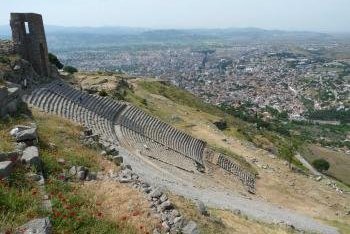
The remains of the ancient Greek city of Pergamon are famous both for their location – notably its Acropolis superbly situated on the top of a steep hill near the modern Turkish town of Bergama, and for the fact that the Pergamon Museum in Berlin holds the magnificent orginal Altar of Zeus removed from the site in 1871. However the inscription of “Pergamon and its Multi-layered Cultural Landscape” shows the site to be a bit more complicated than this!
In fact it consists of 9 locations - the major area which includes not only the Acropolis and the Askeplion healing centre situated a few kms apart but also Roman and Ottoman remains between and a Roman aqueduct to the north. A few kms further away is the Kybele Sanctuary - a rock cut shrine dating originally to pre Hellenistic times and then 7 scattered tumuli . All this was packaged together with its grandiose title. ICOMOS was not convinced and recommended deferral for a number of reasons but primarily to “Refocus the nomination on the Hellenistic and Roman periods to justify the value of the property as the Hellenistic capital of the Attalids and its subsequent inclusion in the Roman Empire which allowed Pergamon to extend its role as a cultural centre”. The WHC overruled ICOMOS on this one and the site was inscribed as nominated!
We too had a problem – just not enough time to cover all the locations! The Tumuli can be seen from the Acropolis and, …
Keep reading 0 comments
